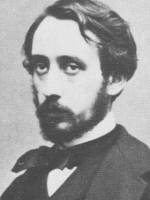
|
Degas is usually classed with the impressionists, and he exhibited with them in seven of the eight impressionist exhibitions. However, his training in classical drafting and his dislike of painting directly from nature produced a style that represented a related alternative to impressionism.
Degas was born into a well-to-do banking family on July 19, 1834, in Paris. He studied at the École des Beaux-Arts under a disciple of the famous French classicist J. A. D. Ingres, where Degas developed the great drawing ability that was to be a salient characteristic of his art. After 1865, under the influence of the budding impressionist movement, he gave up academic subjects to turn to contemporary themes. But, unlike the impressionists, he preferred to work in the studio and was uninterested in the study of natural light that fascinated them. He was attracted by theatrical subjects, and most of his works depict racecourses, theaters, cafés, music halls, or boudoirs. Degas was a keen observer of humanity—particularly of women, with whom his work is preoccupied—and in his portraits as well as in his studies of dancers, milliners, and laundresses, he cultivated a complete objectivity, attempting to catch his subjects in poses as natural and spontaneous as those recorded in action photographs.
His study of Japanese prints led him to experiment with unusual visual angles and asymmetrical compositions. His subjects often appear cropped at the edges, as in Ballet Rehearsal (1876, Glasgow Art Galleries and Museum). In Woman with Chrysanthemums (1865, Metropolitan Museum of Art, New York City), the female subject of the picture is pushed into a corner of the canvas by the large central bouquet of flowers.
In the 1880s, when his eyesight began to fail, Degas began increasingly to work in two new media that did not require intense visual acuity: sculpture and pastel. In his sculpture, as in his paintings, he attempted to catch the action of the moment, and his ballet dancers and female nudes are depicted in poses that make no attempt to conceal their subjects' physical exertions. His pastels are usually simple compositions containing only a few figures. He was obliged to depend on vibrant colors and meaningful gestures rather than on precise lines and careful detailing, but, in spite of such limitations, these works are eloquent and expressive and have a simple grandeur unsurpassed by any of his other works.
Degas was not well known to the public, and his true artistic stature did not become evident until after his death. He died in Paris on September 27, 1917.
|

